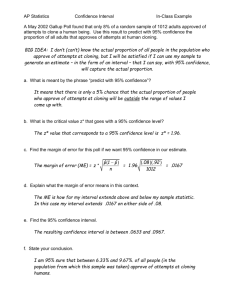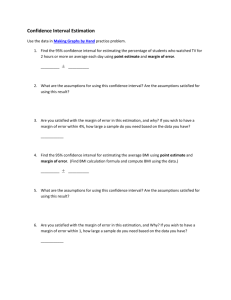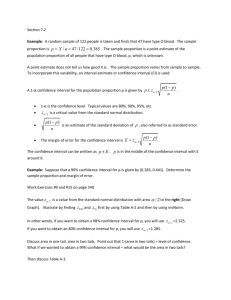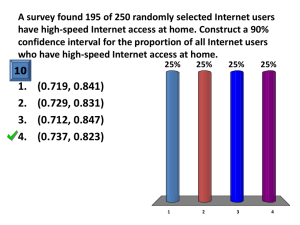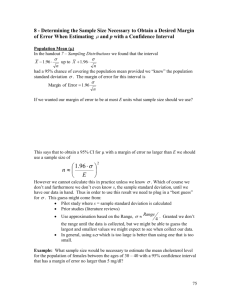AP Statistics: WARM UP #1 Chapter 8 A level C confidence interval
advertisement
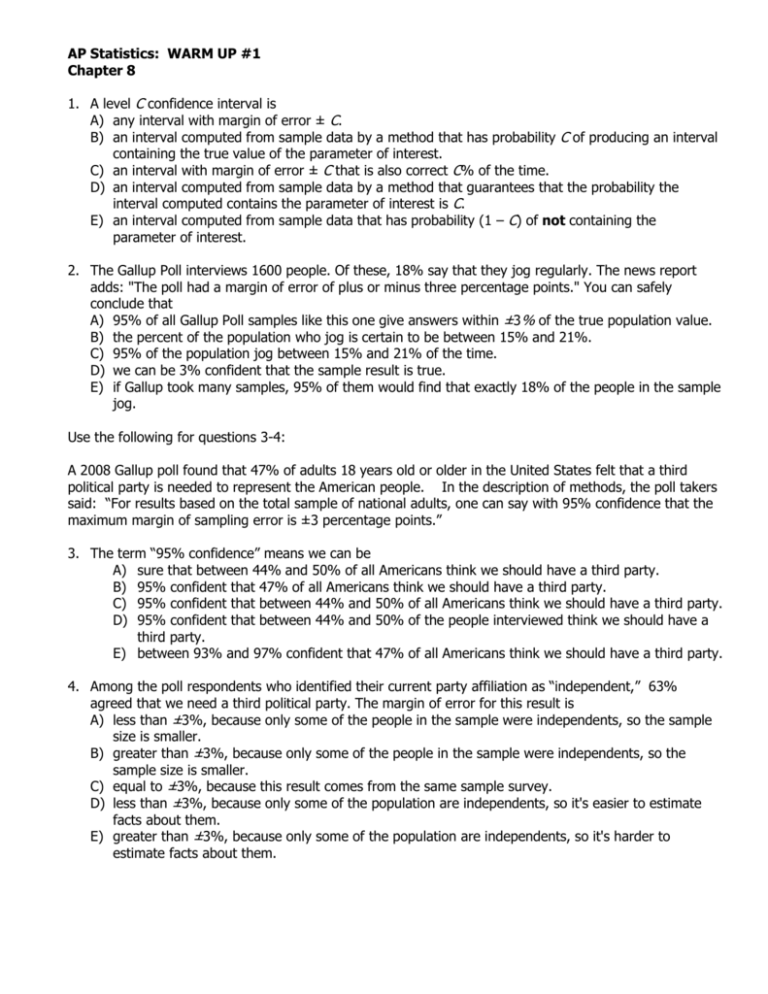
AP Statistics: WARM UP #1 Chapter 8 1. A level C confidence interval is A) any interval with margin of error ± C. B) an interval computed from sample data by a method that has probability C of producing an interval containing the true value of the parameter of interest. C) an interval with margin of error ± C that is also correct C% of the time. D) an interval computed from sample data by a method that guarantees that the probability the interval computed contains the parameter of interest is C. E) an interval computed from sample data that has probability (1 – C) of not containing the parameter of interest. 2. The Gallup Poll interviews 1600 people. Of these, 18% say that they jog regularly. The news report adds: "The poll had a margin of error of plus or minus three percentage points." You can safely conclude that A) 95% of all Gallup Poll samples like this one give answers within ±3% of the true population value. B) the percent of the population who jog is certain to be between 15% and 21%. C) 95% of the population jog between 15% and 21% of the time. D) we can be 3% confident that the sample result is true. E) if Gallup took many samples, 95% of them would find that exactly 18% of the people in the sample jog. Use the following for questions 3-4: A 2008 Gallup poll found that 47% of adults 18 years old or older in the United States felt that a third political party is needed to represent the American people. In the description of methods, the poll takers said: “For results based on the total sample of national adults, one can say with 95% confidence that the maximum margin of sampling error is ±3 percentage points.” 3. The term “95% confidence” means we can be A) sure that between 44% and 50% of all Americans think we should have a third party. B) 95% confident that 47% of all Americans think we should have a third party. C) 95% confident that between 44% and 50% of all Americans think we should have a third party. D) 95% confident that between 44% and 50% of the people interviewed think we should have a third party. E) between 93% and 97% confident that 47% of all Americans think we should have a third party. 4. Among the poll respondents who identified their current party affiliation as “independent,” 63% agreed that we need a third political party. The margin of error for this result is A) less than ±3%, because only some of the people in the sample were independents, so the sample size is smaller. B) greater than ±3%, because only some of the people in the sample were independents, so the sample size is smaller. C) equal to ±3%, because this result comes from the same sample survey. D) less than ±3%, because only some of the population are independents, so it's easier to estimate facts about them. E) greater than ±3%, because only some of the population are independents, so it's harder to estimate facts about them. AP Statistics: WARM UP #2 Chapter 8 1. A polling organization announces that the proportion of American voters who favor congressional term limits is 64 percent, with a 95% confidence margin of error of 3 percent. This means that A) if the poll were conducted again in the same way, there is a 95% chance that the fraction of voters favoring term limits in the second poll would be between 61 percent and 67 percent. B) there is a 95% probability that the true percentage of voters favoring term limits is between 61 and 67 percent. C) if the poll were conducted again the same way, there is a 95% probability that the percentage of voters favoring term limits in the second poll would be within 3 percent of the percentage favoring term limits in the first poll. D) among 95% of the voters, between 61 percent and 67 percent favor term limits. E) none of the above. 2. The critical value used to construct a confidence interval for a proportion depends upon A) The confidence level being used and the size of the sample. B) The size of the sample and the sample proportion. C) The confidence level, the size of the sample, and the standard deviation of the population. D) Only on the sample size. E) Only on the confidence level. 3. A political candidate is told by his polling organization that a 90% confidence interval for the proportion of voters who support his candidacy is 0.45 to 0.53. What are the point estimate and margin of error for this interval? A) Point estimate = 0.50; margin of error = 0.08. B) Point estimate = 0.49; margin of error 90% C) Point estimate = 0.49; margin of error 0.08. D) Point estimate = 0.49; margin of error = 0.04. E) Point estimate = 0.49; margin or error cannot be determined without sample size. 4. Other things being equal, the margin of error of a confidence interval increases as A) the sample size increases. B) the sample mean increases. C) the population standard deviation increases. D) the confidence level decreases. E) none of the above. 5. I collect a random sample of size n from a population and from the data collected compute a 95% confidence interval for the mean of the population. Which of the following would produce a wider confidence interval, based on these same data? A) Use a larger confidence level. B) Use a smaller confidence level. C) Use the same confidence level, but compute the interval n times. Approximately 5% of these intervals will be larger. D) Increase the sample size. E) Nothing can ensure that you will get a larger interval. One can only say the chance of obtaining a larger interval is 0.05. AP Statistics: WARM UP #3 Chapter 8 1. A marketing company discovered the following problems with a recent poll: I. Some people refused to answer questions II People without telephones could not be in the sample III. Some people never answered the phone in several calls. Which of these sources is included in the ±2% margin of error announced for the poll? A) Only source I. B) Only source II. C) Only source III. D) All three sources of error. E) None of these sources of error. 2. A quality control inspector is testing microprocessor chips made during a single day by a new machine to determine the proportion of defective chips. She selects an SRS of 80 chips from the 3000 chips produced by the machine on that day. It turns out that six of the chips are defective. Which of the following conditions for constructing a confidence interval for the proportion of defective chips has been violated? A) npˆ 10 and n 1 pˆ 10 B) C) D) E) An SRS has been taken from the population of interest. The population is at least 10 times the size of the sample. The population is approximately Normally distributed. There appear to be no violations. 3. You are told that the proportion p of those who answered "yes" to a poll about internet use is p = 0.70, and the standard error SEp of the proportion is 0.0459. The sample size was A) is 50. B) is 99. C) is 100. D) is 200. E) cannot be determined from the information given. Use the following to answer questions 4-5: After a college’s football team once again lost a football game to the college’s arch rival, the alumni association conducted a survey to see if alumni were in favor of firing the coach. An SRS of 100 alumni from the population of all living alumni was taken. Sixty-four of the alumni in the sample were in favor of firing the coach. Let p represent the proportion of all living alumni who favor firing the coach. 4. A 95% confidence interval for p is A) 0.64 ± 0.009. B) 0.64 ± 0.079. C) 0.64 ± 0.094. D) 0.64 ± 0.124. E) 0.64 ± 0.360. 5. Which of the following is closest to the sample size you would need to estimate p with a margin of error of 0.05 with 95% confidence? Use 0.5 as an approximation of p. A) 269 B) 385 C) 538 D) 768 E) 1436 AP Statistics: WARM UP #4 Chapter 8 1. Which of the following confidence intervals has the largest critical value? A) A 95% z-interval B) A 95% t-interval with 1 degree of freedom C) A 95% t-interval with 10 degrees of freedom D) A 90% t-interval with 1 degree of freedom E) A 90% t-interval with 10 degrees of freedom 2. What is the critical value t* for a 99% confidence interval when n = 20? A) 2.086 B) 2.093 C) 2.576 D) 2.845 E) 2.861 3. What proportion of scores in a t-distribution with 6 degrees of freedom are above t = 2.447? A) 0.90 B) 0.10 C) 0.05 D) 0.025 E) 0.01 4. The heights (in inches) of males in the United States are believed to be Normally distributed with mean µ. The average height of a random sample of twenty-five American adult males is found to be 𝑥̅ = 69.72 inches and the standard deviation of the twenty-five heights is found to be s = 4.15. The standard error of 𝑥̅ is A) 0.17. B) 0.69. C) 0.83. D) 1.856. E) 2.04. 5. An SRS of 100 postal employees found that the average time these employees had worked for the postal service was 𝑥̅ = 7 years with standard deviation s = 2 years. Assume the distribution of the time the population of employees have worked for the postal service is approximately Normal. A 95% confidence interval for the mean time µ the population of postal service employees have spent with the postal service is A) 7 ± 2. B) 7 ± 1.984. C) 7 ± 0.525. D) 7 ± 0.4. E) 7 ± 0.2. 6. Suppose we want a 90% confidence interval for the average amount spent on books by freshmen in their first year at a major university. The interval is to have a margin of error of no more than $2, and the amount spent has an approximately Normal distribution with a standard deviation σ = $30. The number of observations required is closest to A) 25. B) 30. C) 568. D) 609. E) 865. Answers Chapter 8 MC Warm Ups WU #1 1) B 2) A 3) C 4) B WU #2 1) E 2) E 3) D 4) C 5) A WU #3 1) E 2) A 3) C 4) C 5) B WU #4 1) B 2) E 3) C 5) D 6) D

